Is SolShare Worth It For Multi-Unit Properties?
If you’re a strata-titled property owner researching rooftop solar, you’ve likely come across Allume Energy’s SolShare, a solar-sharing solution that’s turning heads. While this cutting-edge technology has great potential, it’s essential to consider if it’s the right fit for your particular strata. Let’s investigate the details and objectively evaluate SolShare’s compatibility with your property.
This article is not so much about what SolShare is, that’s already been discussed, but more about the pros and cons of installing SolShare compared to another option – installing individual rooftop solar systems.
First, let me say, in my opinion, if you find through your research that the economics of having one or multiple SolShares installed is marginal, or not as economic as individual solar systems, I would strongly err on the side of getting the SolShare/s because of the value it brings with intangible benefits.
Let’s take a look at the pros and cons of “Installing SolShare” vs “Individual Systems”, and while we’re at it – a “Do Nothing” (business as usual – no solar) scenario. After that are some wise words from a well-respected impartial professional in this field, including advice on adding batteries to Solshare.
Installing SolShare
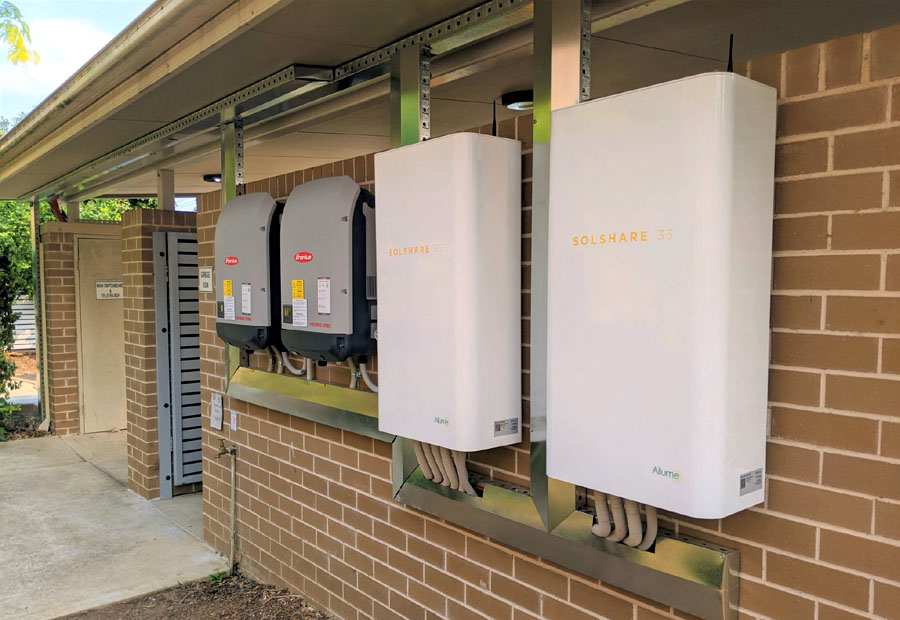
What’s twice as good as a SolShare? A pair of SolShares of course. Image: Allume Energy
Pros
– Maximum utilization of solar power for self-consumption.
As the name says – SolShare enables the solar output to be shared equitably between connected apartments so all can reap the economic and other benefits of solar self-consumption. Allume Energy claims SolShare will increase self-consumption by 40-50%.
– Increased grid stability.
Solar self-consumption means electricity going where it’s needed more efficiently. This leads to voltage drop/ rise staying within manageable limits as the network operator balances supply and demand.
– Lower transmission losses.
Maximizing solar self-consumption means lower electricity transmission losses of up to 10%1. These losses are typically not taken into account by potential solar owners doing back-of-envelope calculations.
– Avoids losses from export limits.
Another benefit of maximizing solar self-consumption with SolShare is that it can help to avoid potential losses incurred by export limits imposed by the Distributed Network Service Provider.
– Reduced solar installation costs.
Installing one larger solar system vs multiple small systems is cheaper per installed kilowatt due to economies of scale (although this may be offset by the SolShare installation cost). More on that later.
– Keep your own electricity retailer and plan.
Installing a SolShare doesn’t restrict or affect which electricity retailer or plan you’re able to use. You can make your own choice and pay your own bills regardless of what your neighbour does.
– Joining is not mandatory for strata owners.
Strata owners can opt out initially and join later if they want. This reduces strata politics. The apartments can be connected so owners or new residents can participate at a later time if they wish.
– Capital gains.
The Domain Sustainability Report 2022 concluded that homes with energy-efficient features spend less time on the market, have a higher volume of views, and sell at a premium when compared with homes without. A difference across Australia of between +$72,750 for units and +$125,000 for houses in 2022.
– Perks for landlords.
More benefits for property investors if you’re a landlord – tax breaks, rent increases, and cheaper electricity for tenants.
– Maintenance is cheaper.
It’s cheaper to have a large system maintained and split costs than have your guy come out just for your own individual system inspection.
– Good warranty outcomes are more likely.
Imagine dealing with warranty issues on your own. There’s safety in numbers. You’re much more likely to get a good warranty outcome with the whole strata body making a noise.
Cons
– Negotiation is needed with the strata body and owners.
This is perhaps the biggest roadblock for strata owners wishing to install solar regardless of whether it’s done with a SolShare device or not. Consultation with other owners and the strata body is mandatory.
– Uneconomical for less than 6 single-phase residential units.
Each SolShare can supply 15 single-phase apartments, however, it’s usually uneconomical for less than 6. There are workarounds – see below.
– May be unsuitable if metering is not co-located on/ near one switchboard.
In most instances, the electricity meters associated with each SolShare have to be co-located on or near the same switchboard, otherwise expensive cabling is needed which blows out the costs.
– Plans with high feed-in tariffs may not be cost-effective.
Although high feed-in tariffs seem to be a thing of the past, they still exist. If you’re lucky enough to be on a legacy electricity plan with a high feed-in tariff you should do your sums, because aiming for maximum solar self-consumption might not achieve the best economic outcome.
– A feasibility study may be needed to determine suitability.
Due to the complexity of strata properties and the diverse group of people living within them, a feasibility study by experts is the best way to determine the path forward and put all options on the table. Add that to the bill.
Individual Rooftop Solar
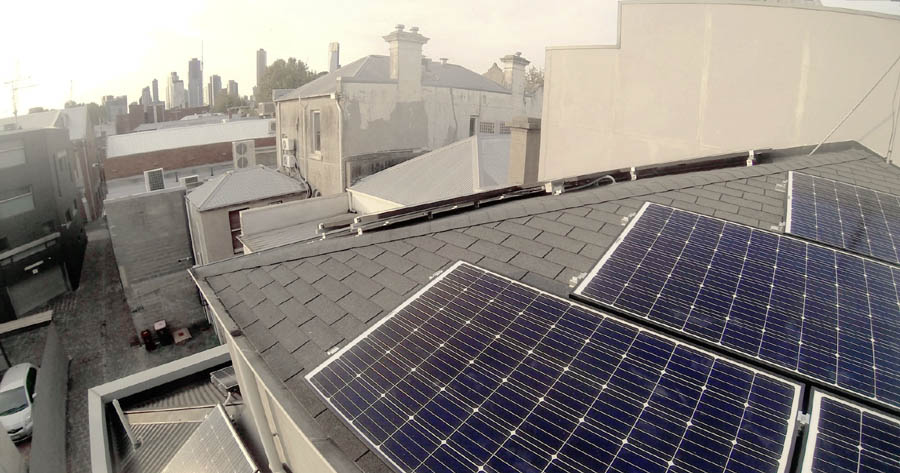
This strata owner did his own thing, and went through layers of bureaucracy to get a system up on his roof. Image: Scott Watkins
Pros
– You’re in control.
If you think you can achieve a better outcome on your own than joining the pack then go for it. Bear in mind that this might take more of a hands-on approach to get the job done, and monitor your solar self-consumption.
– Keep your own electricity retailer and plan.
You’re doing your own thing. It’s nobody else’s business who your electricity retailer is or what plan you’re on.
– Capital gains.
The same as with the SolShare scenario – according to the Domain Sustainability Report 2022 homes with energy-efficient features sell at a premium when compared with homes without. A difference across Australia of between +$72,750 for Units and +$125,000 for Houses in 2022.
– Perks for landlords.
As above – more benefits for property investors if you’re a landlord – tax breaks, rent increases, and cheaper electricity for tenants.
Cons
– Negotiation is needed with the strata body and owners.
As above – this is the biggest roadblock for strata owners wishing to install solar regardless of whether it’s done with a SolShare device or not. You have to consult with other owners and the strata body.
– Self-consumption of solar power may not be optimal.
It’s harder to achieve the most optimal use of solar power with an individual rooftop solar power system. The SolShare was primarily designed to address this problem.
– Higher solar installation costs.
The opposite of the SolsShare scenario – Installing multiple small rooftop solar systems vs one larger system is more expensive per installed kilowatt due to economies of scale (although this may be offset by the SolShare installation cost). More on that later.
– Maintenance is more expensive.
As above – it’s cheaper to have a large system maintained and split costs than have your guy come out just for your own system inspection.
– Potential warranty hassles.
Add to the above the hassle and worry of dealing with warranty issues on your own. There’s safety in numbers. Don’t take a good warranty outcome for granted. You’re much less likely to get a good outcome without the whole strata body behind you.
– Not the best use of roof space.
If you’re doing your own thing – a single rooftop solar system might not be the best use of roof space, and may compromise the feasibility of a larger communal system at a later date. Try to make that part of the thought process because the solar array will hopefully be there for many years.
Do Nothing (No Solar)

Life is easy if you don’t have to think. Image: Pexels
Pros
– Nothing to think about. Business as usual.
Just get on with your life, forget about this solar rubbish, and do the things that make your life better right now *cracks open another beer*.
– No negotiation is needed with the strata body and owners.
Stuff that bunch of w*nkers. Who needs friends anyway. It’s bad enough that you have to look them in the eye when you pass them in the street.
Cons
– Pay more for electricity.
Really? Yes really.
– No capital gains.
What? Yep. You might be missing out on between +$72,750 for units and +$125,000 for houses.
– No perks for landlords.
Man, this property investment gig sucks.
– Burn in hell.
If there’s such a thing as hell you’ll be right in the middle of the bonfire you selfish b*stard. Karma will get you for not participating in something worthwhile that’s for your own benefit – and your kids.
** END OF SATIRICAL RANT **
Some Tips From A Pro
Brent Clark is the CEO and one of the founders of Wattblock, a company that provides independent advice on sustainability energy to strata committees, strata managers, and local councils. He lives and breathes this stuff.
Brent has spent the last 11 years assisting various authorities, and done many feasibility studies on this very subject, so who better to speak with to get an impartial view? That’s just what I did, and here are some key takeaways from our conversation:
Size Considerations for SolShare
SolShare and Small Townhouses
“SolShare may not be the right fit for small townhouses. You really need a minimum of six apartments that want to be involved to make SolShare the preferred solution. It becomes more and more attractive as you move towards the maximum limit, which is 15 apartments per SolShare device.”
The Economics of Multiple Apartments and SolShares
“Then SolShare can become uneconomical again from 16 to 20 apartments because you have the expense of adding another SolShare. At that point, it may be better to have one SolShare, plus another couple of individual rooftop solar systems not connected to the SolShare device. The equation changes again as you add SolShare devices. It becomes attractive again for 2 SolShares across 25 to 30 apartments, or 3 SolShares across 40 to 45 apartments.”
Rooftop Solar System Sizing with SolShare
Reducing Rooftop Solar System Size
“Having a SolShare means that you can reduce the size of the rooftop solar system needed, compared to having individual solar systems. Theoretically, you can install up to 40% smaller rooftop solar system with a SolShare for the same number of units, compared with doing individual solar systems for each of those units.”
Practical Considerations and Battery Viability
“In practice, it can be more complicated than that. For example, if you strip back more than about 20% of the size that you would normally install for individual solar systems, it may end up not having enough throughput to make batteries viable if you add them at a later stage.”
Don’t go too small with individual systems
“As SolarQuotes quite often says – “Go maximum size if you have the roof space for it.” It’s definitely better to go with a larger system, rather than screwing it down to the smallest possible system that you can get away with on top of the SolShare.”
Battery Economics and Management with SolShare
Current Limitations of Batteries with SolShare
“Having said that – right now it’s not really economical to add batteries to SolShare. The other thing is that SolShare doesn’t currently manage the power coming out of batteries equitably amongst the apartments. It’s just on a 1st come 1st served basis. So although you have the fairness in equity of the shared solar system, the same doesn’t apply to a shared battery.”
Larger SolShare Implementations
Upper Limits and Alternative Solutions
“The largest SolShare implementations that I’m aware of in Australia are 60 apartments. On the top end, if you had 80 apartments and you wanted to share solar, then you would perhaps consider an embedded electrical network, rather than going down the SolShare path.”
Feasibility Studies and Challenges
Constrained Roof Space and Common Area Systems
“So, SolShare works from 6 up to about 60 apartments (single-phase). We’ve done feasibility studies on many scenarios such as SolShare vs individual systems, and SolShare vs embedded networks. If you have constrained roof space the SolShare is a competitor to a common area solar system.”
Multiple Solar Systems for Larger Buildings
“Alternatively, if you have a decent common area load such as a building that has 30 or so units, you might want to silo part of the roof space for a common area system. Because of the limits of 30kW panel capacity, there’s a point where it’s better to have two solar systems – one for the common area and another that’s connected to one or more SolShares for individual apartments.”
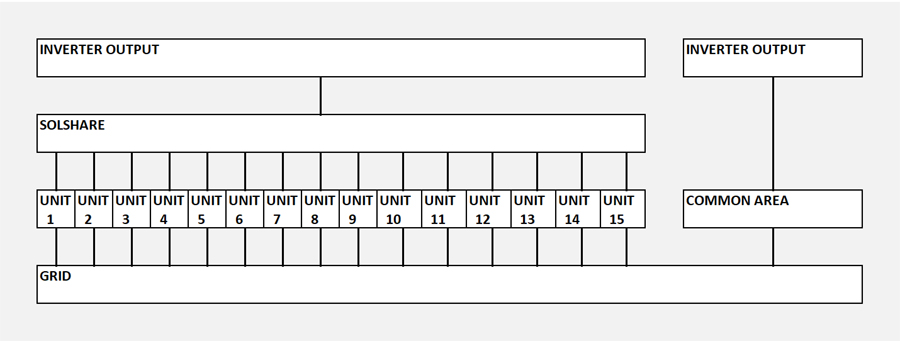
Basic configuration for SolShare supplying 15 residential units plus a separate system for the common area.
Cabling and Metering Challenges
“There’s one other thing that really strikes out the SolShare. That’s when the meters for individual apartments are in electrical cabinets on different floors going up the building. If you’ve got 6 meters on each of the 5 floors going up it’s not going to be that economical to do the job.”
“For each SolShare you want clumps of co-located meters in the same room. For multiple SolShares, the meters can be on separate floors/ locations, but still co-located for each SolShare. This is because of the expense of extra cabling plus possible core drilling concrete floors to accommodate.”
Easing Strata Committees into Solar Investments
“The other challenge for strata is that when we’re doing a feasibility study, we’re trying to enable that first step forward and at least request quotes, and not just say this is too expensive so throwing the baby out with the bathwater at the initial stage.”
“If the first number that the strata committee sees is big then there’s a risk that they just throw their hands up and say we’re not doing it. It’s sometimes better to get them invested by using, for example, that 40% optimized size that we talked about first. Then you may get a groundswell of owners saying yes we want this. Next thing it’s them pushing the size of the solar system up.”
Show Me The Numbers
That’s a big ask for a couple of reasons. (1) No strata complex is the same. (2) No before and after study of SolShare has been undertaken, in part because of the complexity of owners having separate electricity retailers and plans.
I did manage to get Brent to throw me a couple of speculative numbers:
“A SolShare plus installation might be $20,000. That’s on top of the cost of the solar system. If you spread the cost of the SolShare and installation over 15 units, that’s about $1,300 each, plus the cost of the rooftop solar system.”
“At 19 apartments you’d need a second SolShare for another $20,000. You could probably do 4 individual 4kW solar systems cheaper than adding the second SolShare. So for 19 apartments the best economics might be one SolShare and solar system for the first 15 apartments, and 4 individual 4kW solar systems for the remaining 4 apartments.”
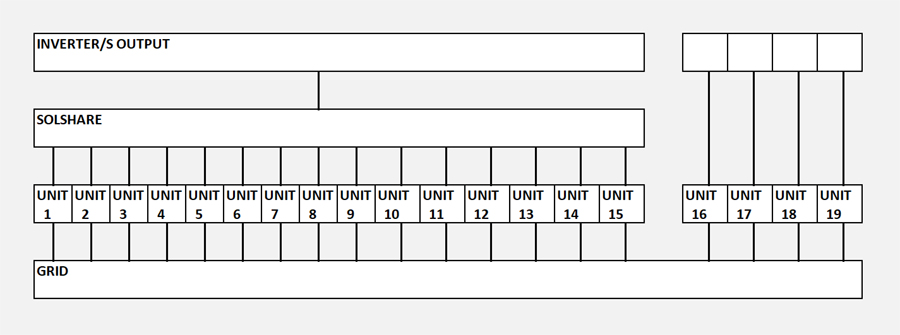
Basic configuration for SolShare supplying 15 residential units plus separate individual solar systems for the remaining 4 units.
Throw in the cost of a feasibility study on top of that – upwards of $9002. This is a highly recommended part of the process. Do it or risk throwing good money after bad.
Now with over 150 SolShare installations across Australia, numerous case studies exist on the Allume Energy and Wattbock websites. These, unfortunately don’t go into great detail regarding number crunching, but it’s a start.
Down The Rabbit Hole
How much time have you got to research the giant rabbit hole of solar for strata? The Wattblock website is a good starting point. Brent recommends this Solar Readiness for Strata online training course, and a number of videos on solar for strata. There’s also this article about a determined strata owner that jumped through the hoops of bureaucracy and got his own rooftop solar system up.
Good luck. Fortune favours the brave.
Footnotes
- In the report titled “Electricity Statement of Opportunities” (ESOO) for 2021, AEMO states that “Energy losses on the NEM transmission network were 6.1% in 2020-21, up from 5.9% in 2019-20. In addition, a small proportion of energy is lost within distribution networks and at customer premises. In total, around 9-10% of electricity generated within the NEM is lost before it reaches end-use customers. ↩
- Your local council might pay for this! ↩

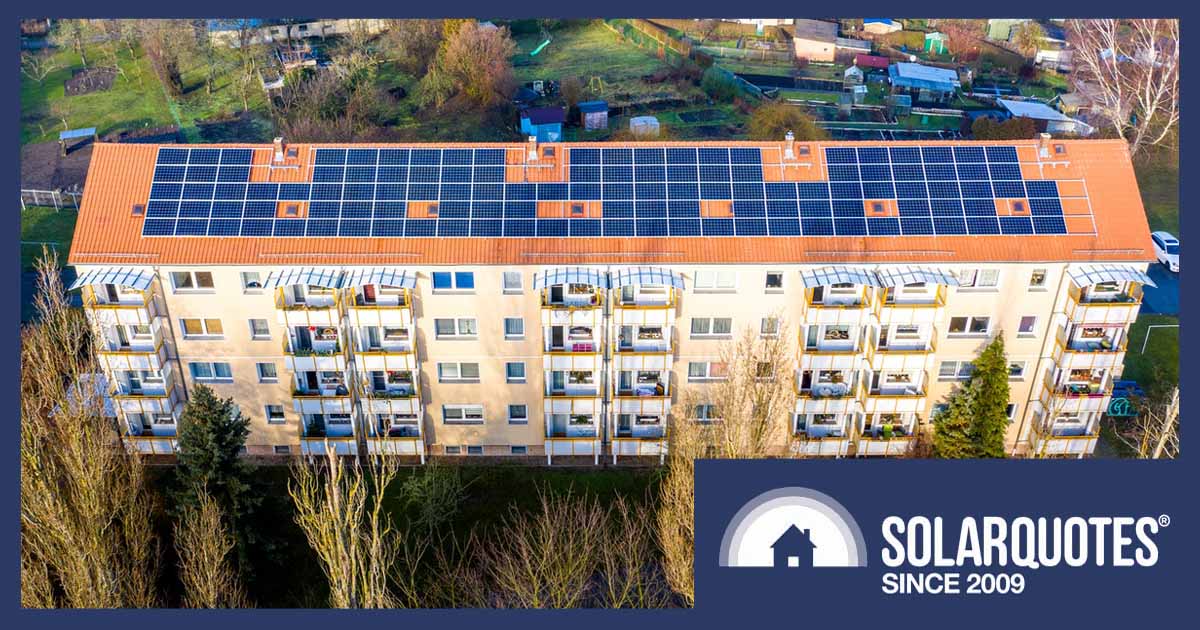
 RSS - Posts
RSS - Posts



Looks to me like another grid-tied system with no way to connect batteries to it without a Tesla-style expensive solution. Having a system that charges batteries and uses power directly from them is better planned for at the start rather than having to fix it later with a Tesla-type solution. The cost of batteries will come down and are already at a break-even cost. All systems will/ should have batteries shortly. Batteries would be cash positive now. But Tesla powerwalls are a long way off being cash positive as a solution. It’s really wrong when an installer talks about adding batteries when what they really mean is an integrated power management system that contains batteries… A full subsystem.
We really need a NSW government rebate on the batteries, to make it economical for a strata building to start pairing batteries with Solshare. (potentially three batteries for each solshare, with 5 single phase apartments each sharing a battery on a first come, first serve basis).
A $3,000 rebate on each 13.3kWh battery might do the trick.
Hi Norman,
Will from Allume here!
There are now some 3-Phase battery options (either AC Coupled or DC coupled) to be used with Solshare. This presents an alternative scenario to Tesla Powerwall’s. Please feel free to get in touch with myself directly, otherwise Brent is a great point of contact.
Cheers!
My body corporate obtained a quote for Solshare and we ended up not proceeding due to the limitation of the system. The limited kW capacity of each Solshare (I forget the kW capacity per Solshare, but it’s too small), and the cost per Solshare unit, meant that the suggested system was way too small in kW capacity compared to the almost 100 kWs of panels that would fit on the roof. We all wanted to max out the roof’s solar production, not to limit our production as was proposed for a Solshare system.
If each Solshare unit could handle a lot more kW of panels, then we would have proceeded.
Unfortunately, we still have no solar. There is the embedded network option, but I’m not keen on that because it locks everyone into the same electricity retailer – and I need to be able to choose my retailer in order to receive my electricity bill credits after buying into the (in development) Haystacks community solar farm.
I would love to hear if anyone can suggest a workable solution for our building. We want to max out the roof with panels. Thank you.
Multiple solar systems can be installed on strata rooftops with large roofspaces. These solar systems can be installed at different times over the coming years.
A separate solar/battery system with its own inverter can be installed for the common areas of the building (often a three phase meter), which can be oversized to futureproof the building for electric vehicle charging in the future.
In addition, one or more solshare connected solar systems (30kW each) can be connected to sets of 15 individual apartment meters. The solshare + 30kW solar systems could be phased in over time, as groups of apartment owners want to connect up and make the switch to access renewable energy.
Late to the party I know, but I’m hoping this can be answered here even a year later.
We are looking at the SolShare for a complex of 14 Townhouses with shared garage and meter boards. The design provided is 20kW inverter with 26kW of panels, we have significantly more room for panels.
What I haven’t been able to find is why an equal share of the power generated through a SolShare is sufficient for our complex (equiv. to ~1.3kW share with common power) when everywhere else says maximise solar, bigger is better and the norm is a 6.6kW system (5kW inverter).
How can you compare a SolShare design with a individual unit design? The sizing just doesn’t seem to make much sense?
Hi Kate,
I’m not sure how you could compare a Solshare system however solaranalytics would be able to monitor the whole site if you want to get real time data on the aggregate consumption. Individual owners should be able to obtain meter data for their own accounts with a process outlined here :
https://support.solarquotes.com.au/hc/en-us/articles/360001312176-How-to-access-your-smart-meter-data
In 15 years doing solar the only consistent complaint I’ve heard is “gee I wish we had more”
Thanks Anthony,
What we are trying to compare is whether the solshare design is as good as going for a 14x5kW inverter system (noting an undersized solar array of 62kW and a flat roof slightly south sloping). The solshare is half the cost but the multi inverter system design projects almost double the saving. There are ongoing maintenance costs to consider but both systems should fit into the space we have, though obviously one will take up significantly more room on common property.
The major advantage of solshare is that it’s easy to do unit entitlement. But I think the strata committee are all just worried it isn’t big enough, and doesn’t future proof. We did get given a design that doubles the solshare kW (three solshare) but the company is still recommending their smaller design because the larger system would send most additional power produced to the grid.
What would be amazing is if there was a statement that said for a maxed solshare (ie 15 units) it is equivalent of each unit getting an individual system size of x. I just haven’t been able to find anything like that except potentially the statement that it performs like a system 40% larger. But again because each unit theoretically gets use of a 20kW system is that better than having sole use of a 5kW system with undersized array?
All of the questions, none of the answers. The bigger is better statement is all I read but is a 20kW shared system technically bigger than 14x5kW individual systems…
Kate
@Kate. A problem with the point of view that you don’t want to produce more energy than you use, is that it doesn’t future proof the system for EVs and other high energy uses.
I previously had an assessment of my apt block for Solshare but I was disappointed by how small the recommended system size was, especially when our roof can fit a lot more solar. We didn’t proceed with Solshare.
I’m now charging my EV at my apartment soaking up middle of the day grid electricity when the grid is most green – but I would have preferred a much larger Solshare system and to be charging my EV with solar from my building that would otherwise be sent to the grid.
Hi Phil,
ZECO Energy has a solution – contact Ian at [email protected] and happy to discuss options with you.
Look forward to hearing from you.
How many EVs does the complex have as there is a HOEM.cc solution.
The problem is installing solar, not EV charging. Current EVs are charged from 15 amp powerpoints with no problem. We don’t want to install anything more than powerpoints for EV charging.
Hi Phil,
What we need is 10a or 15a power points absolutely everywhere you can park a car during the day. There’s lots of surplus solar we need to soak up.
Great post Kim!
Will here from Allume!
I also wanted to add a couple of quick points around SolShare project types.
Quite often a lot of apartment complexes will have their electricity meters on a ‘per floor’ basis, this is absolutely fine and can work very well with SolShare. I would advise getting in touch with either Allume directly to discuss the ins and outs of the site, or getting in touch with a reputable consultant such as Wattblock.
If anyone has any other queries, please feel free to get in touch with us directly through the website, or simply flick through a reply on here!
why is the only open a 15 unit model?
will there be smaller or larger models comming out to allow for more flexablity?
Hello
I’m a little confused why this is even needed.
Whats wrong with the PV having a generation meter and each apartment having its own electricity consumption meter, and then the solar energy divided out between each apartment.
Eg
PV produces 100,000 kWh/yr
10 apartments, so each has 10,000kWh of solar each
I’m just not sure what problem solshare solves?
Or have i missed somethign blindingly obvious?
Hi Kate,
Units and townhouses typically use less power than houses.
6.6kW installed on a house often feeds half of the solar back into the grid at certain times of the day.
Allume Solshare runs an algorithm to optimise the use of the single solar system across a number units or townhouses. I’ve seen the claim that this means you would need up to 40% less solar panels in a shared system on a per lot basis, than if you were installing for individual solar systems that couldn’t be optimised across units.
A unit without electric hot water might only need ~1.5kW share of a shared solar system.
Thanks Brent,
We all have instantaneous 3 phase electric hot water so I guess that would mean more than 1.5kW share required to get optimal savings. I think the SolShare solution is telling us ~30% savings on power bills.
An alternate question is, with a flat roof and no shading what estimated size of individual system would I need to save an average of $600 a year when my average daily usage is 18kW? And what sized individual system would I need to save an average of $1200?
As you can see I am well and truly down the rabbit hole, but I am also trying to get independent views on design options that I can then use to help inform the EC’s decision.
Kate